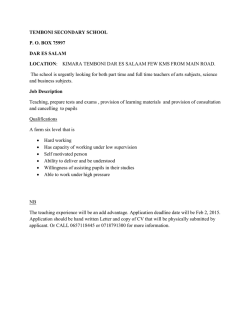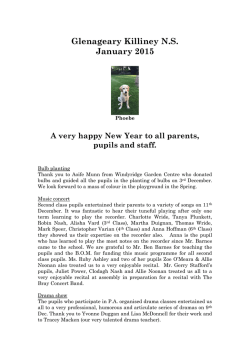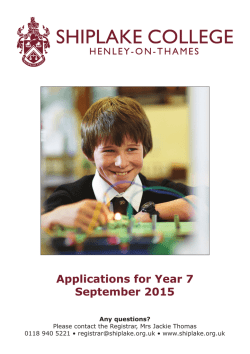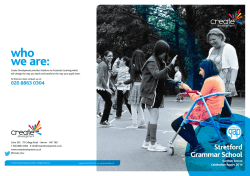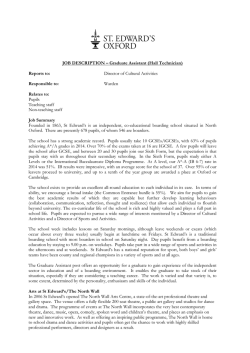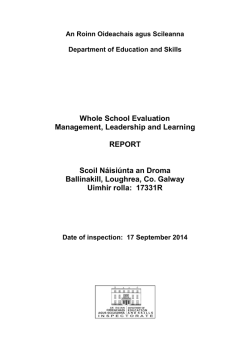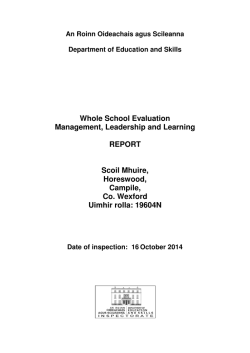
kurikulum standard sekolah rendah pendidikan khas
DRAF KEMENTERIAN PELAJARAN MALAYSIA KURIKULUM STANDARD SEKOLAH RENDAH PENDIDIKAN KHAS (MASALAH PENDENGARAN) BAHASA INGGERIS TAHUN EMPAT 2013 DOKUMEN STANDARD KURIKULUM STANDARD SEKOLAH RENDAH PENDIDIKAN KHAS (MASALAH PENDENGARAN) BAHASA INGGERIS TAHUN 4 BAHAGIAN PEMBANGUNAN KURIKULUM Cetakan Pertama 2012 © Kementerian Pelajaran Malaysia Hak Cipta Terpelihara. Tidak dibenarkan mengeluar ulang mana-mana bahagian artikel, ilustrasi dan isi kandungan buku ini dalam apa juga bentuk dan dengan cara apa jua sama ada secara elektronik, fotokopi, mekanik, rakaman atau cara lain sebelum mendapat kebenaran bertulis daripada Pengarah, Bahagian Pembangunan Kurikulum, Kementerian Pelajaran Malaysia, Aras 4-8, Blok E9, Parcel E, Kompleks Pentadbiran Kerajaan Persekutuan, 62604 Putrajaya. CONTENTS PAGES Rukun Negara v Falsafah Pendididkan Negara vi Pendahuluan vii Introduction 1 Listening and Speaking 8 Reading 10 Writing 12 Language Arts 14 Grammar 16 Word List 18 RUKUN NEGARA RUKUN NEGARA BAHAWASANYA negara kita Malaysia mendukung cita- cita untuk mencapai perpaduan yang lebih erat dalam kalangan seluruh masyarakatnya; memelihara satu cara hidup demokratik; mencipta masyarakat yang adil bagi kemakmuran negara yang akan dapat dinikmati bersama secara adil dan saksama; menjamin satu cara yang liberal terhadap tradisi-tradisi kebudayaannya yang kaya dan berbagai-bagai corak; membina satu masyarakat progresif yang akan menggunakan sains dan teknologi moden; MAKA KAMI, rakyat Malaysia, berikrar akan menumpukan seluruh tenaga dan usaha kami untuk mencapai cita-cita tersebut berdasarkan atas prinsip-prinsip yang berikut: x x x x x KEPERCAYAAN KEPADA TUHAN KESETIAAN KEPADA RAJA DAN NEGARA KELUHURAN PERLEMBAGAAN KEDAULATAN UNDANG-UNDANG KESOPANAN DAN KESUSILAAN v Pendidikan di Malaysia adalah suatu usaha berterusan ke arah lebih memperkembangkan potensi individu secara menyeluruh dan bersepadu untuk melahirkan insan yang seimbang dan harmonis dari segi intelek, rohani, emosi dan jasmani berdasarkan kepercayaan dan kepatuhan kepada Tuhan. Usaha ini adalah bertujuan untuk melahirkan warganegara Malaysia yang berilmu pengetahuan, berketerampilan, berakhlak mulia, bertanggungjawab dan berkeupayaan mencapai kesejahteraan diri serta memberikan sumbangan terhadap keharmonian dan kemakmuran keluarga, masyarakat dan negara. vi menyediakan pendidikan berkualiti secara optimum untuk murid PENDAHULUAN bermasalah pendengaran supaya mereka menjadi insan yang Kurikulum Standard Sekolah Rendah (KSSR) Pendidikan Khas seimbang, berdikari dan berjaya dalam kehidupan. (Masalah Pendengaran) dibina selaras dengan Falsafah Pendidikan Kebangsaan berlandaskan prinsip-prinsip pendekatan bersepadu, MATLAMAT perkembangan individu secara menyeluruh, peluang pendidikan dan kualiti pendidikan yang sama untuk semua murid dan KSSR Pendidikan Khas (Masalah pendidikan matlamat seumur hidup. KSSR Pendidikan Khas (Masalah Pendengaran) digubal dengan untuk mengembangkan potensi muridsecara Pendengaran) adalah bersifat holistik, tidak terlalu akademik dan menyeluruh, seimbang dan bersepadu serta bersesuaian dengan tidak membebankan murid, ini selaras dengan teras kedua Pelan tahap kefungsian murid. Perkembangan ini juga meliputi aspek Induk Pembangunan Pendidikan. jasmani, emosi, rohani, intelek dan social bagi melahirkan insan yang seimbang, harmonis dan berakhlak mulia. Bagi memenuhi keperluan individu, KSSR Pendidikan Khas (Masalah Pendengaran) dibentuk secara fleksibel dan ini bertepatan OBJEKTIF dengan Akta Pendidikan 1996, Bab 8 Pendidikan Khas, Seksyen 41, Subseksyen (1) (b) Peraturan-Peraturan Pendidikan (Pendidikan Khas) 1997, yang menyatakan “ guru-guru boleh mengubahsuai KSSR Pendidikan Khas (Masalah Pendengaran) membolehkan kaedah atau teknik pengajaran atau pembelajaran, masa bagi murid: aktiviti i. dan susunan aktiviti, mata pelajaran dan bahan bantu mengamalkan tingkah laku dan sikap positif dalam menguruskan kehidupan seharian yang lebih bermakna mengajar bagi mencapai tujuan dan matlamat pendidikan khas ”. serta menjadi warganegara yang berguna; ii. KSSR Pendidikan Khas (Masalah Pendengaran) dibina supaya pembelajaran yang dalam berdikari dalam kehidupan seharian; diperoleh di bilik darjah dapat diaplikasikan kehidupan seharian. Kurikulum ini mengaplikasi pengetahuan dan kemahiran serta dapat juga vii iii. iv. v. i. komunikasi kehidupan berkerjaya; ii. kerohanian, sikap dan nilai mengamalkan penjagaan kesihatan dan keselamatan diri iii. kemanusiaan dengan sempurna; iv. sains dan teknologi menggunakan kemahiran berbahasa untuk berkomunikasi, v. perkembangan fizikal dan estetika berinteraksi dan bersosialisasi sejajar dengan vi. keterampilan diri menunjukkan kemahiran dan keterampilan ke arah tatasusila masyarakat majmuk; vi. mengamalkan nilai-nilai Islam dalam kehidupan seharian bagi yang beragama Islam; vii. mengamalkan nilai-nilai murni dalam kehidupan seharian; viii. melibatkan diri dalam aktiviti riadah; ix. menghargai keindahan alam dan warisan budaya; dan x. menggunakan kemahiran teknologi maklumat dan komunikasi seiring dengan perkembangan semasa. STANDARD KURIKULUM BERASASKAN TUNJANG Organisasi Kurikulum Berasaskan Tunjang dibina bagi membangunkan modal berketerampilan. Tunjang (Rajah 1) merupakan domain utama insan yang berpengetahuan dan yang saling menyokong antara satu sama lain bagi membentuk insan yang seimbang dari segi jasmani, emosi, rohani, intelek dan sosial. Domain bagi setiap tunjang adalah: Rajah 1 : Reka Bentuk Kurikulum Standard Sekolah Rendah viii In the Language Arts module, pupils will develop an appreciation for a range of literature written in English, including the works of Malaysian writers. This module provides opportunities for pupils to engage in activities that will allow them to enjoy stories, poems, songs, rhymes and plays written in English. In addition, this module provides pupils an opportunity to integrate, experiment and apply what they have learnt in the other modules in fun-filled, activity-based and meaningful experiences. KSSR ENGLISH LANGUAGE FOR SPECIAL NEEDS (HEARING IMPAIRED) INTRODUCTION English is learnt as a second language by pupils at all levels in the Malaysian education system. The mastery of English is essential for pupils to gain access to the body of information and knowledge written in English. In the light of the growing status of English as an international language for knowledge-sharing, the need to acquire a good command of this language has become urgent. In this curriculum document, the word ‘text’ refers to any written, signed (spoken) or visual communication involving language. It covers, among others, pictures, stories, newspaper articles or reports, advertisements, brochures, letters, conversations, speeches, plays, movies, TV programmes, online linear and non-linear texts, poems and songs. The Standard-based English Language Curriculum is organised in five modules: x Listening and Speaking (seeing & signing) x Reading (signing) x Writing x Language Arts x Grammar This curriculum stresses on the development of critical literacy. Teachers will provide opportunities for pupils to question and evaluate texts that they listen to (see), read (sign) or view. These opportunities are essential for achieving personal growth and confidence in functioning as an effective and productive member of our society. This is in line with the goals of National Philosophy of Education which seeks to optimise the intellectual, emotional and spiritual potential of pupils. The above interrelated modules contain content and learning standards that describe the knowledge, skills and understandings that pupils need to demonstrate as they progress through the different stages of schooling. The standards specify the knowledge and skills that pupils need to demonstrate as they listen (see), speak (sign), read (sign) and write in English. When pupils engage in English learning experiences as described in this curriculum, they view, develop the ability to listen (see), speak (sign), read (sign) and write in English meaningfully and purposefully with confidence. The inclusion of the module on Grammar emphasises the importance of having learners develop a sound grasp of the language structures and grammar of Standard British English. UNDERLYING CURRICULUM PEDAGOGICAL PRINCIPLES OF THE The approach adopted in the Standard-based curriculum is underpinned by the following principles: x Back to basics - building a strong foundation of competencies in basic literacy skills, reading (signing) through whole-word, letter-by-letter, penmanship, listening (seeing) and speaking (signing). 1 x x x x x Learning is fun, meaningful and purposeful - activities are contextualised, meaningful and purposeful; fun-filled activities - integration of language skills in meaningful contexts AIMS The English Language syllabus for primary school aims to equip pupils with basic skills and knowledge of the English Language so as to enable them to communicate, both orally (signing) and in writing, in and out of school. Teaching is learner-centered - learner’s needs and salient learner factors - emphasis on mastery learning OBJECTIVES By the end of Year 3, pupils should be able to : Integration of salient new technologies - exploiting new technologies in language learning - using technology to enhance communication x x Assessment for learning - emphasising on formative school-based assessment - using a range of activities to assess performance x x Infusing character-building - inculcating moral values - promoting more instructional conversation communicate with peers and adults on simple topics in spontaneous and structured classroom activities. read or sign and comprehend a range of simple texts on familiar topics for information and enjoyment. write a range of simple texts through a variety of media with minimal grammatical errors. read or sign and demonstrate understanding of poems, stories and plays, and produce creative works for enjoyment. CURRICULUM ORGANISATION The Standard-based English Language Curriculum for Malaysian Primary Schools is designed to provide learners with a strong foundation in the English Language. The document is for the hearing impaired in the special schools and integrated programmes. Relevant curriculum supporting documents will be made available to help teachers implement the curriculum more effectively. This document outlines the aims, objectives, content and learning standards as well as the modes of assessment for the English Language programmes in primary schools. The above principles draw on insights from a number of sources. They are informed by discussions with classroom practitioners, school heads, teacher trainers, curriculum leaders in schools, district and state education departments, state language officers, parents, representatives from the private sector as well as pupils. They also represent a consolidation of what has been learnt in the implementation of the earlier curriculum through focus group discussions, workshops, classroom observations, school visits and researches. 2 English is the second language for pupils. It is believed prudent and pedagogically sound to defer the learning of grammar to a later stage. Pupils should be given the opportunity to develop an awareness of grammar in their first language and this awareness may then be exploited when English grammar is introduced in Year 3. This approach will reduce the load and stress of learning in the early years where the emphasis is on learning through fun and play. The curriculum is modular in design and this is reflected in the organisation of the content and learning standards. Primary Special Education is divided into two stages: x x Stage One - Reinforcement Year, Year 1, 2 and 3 Stage Two - Year 4, 5 and 6 In the initial stage of learning English, pupils will have the opportunity to listen to (see) meaningful English input, in the form of stories or oral (signed) descriptions by teachers based on graphic texts. Through listening (seeing), pupils will become familiar with words that will be introduced in the early reading and writing lessons. The emphasis in the initial stages will be on vocabulary acquisition. In Reinforcement Year, Year 1 and 2, curriculum emphasises the development of basic language skills so that pupils will have a strong foundation to build their proficiency in the language. In this initial stage, there are four modules; namely: ¾ Module One ¾ ¾ ¾ Module Two Module Three Module Four : Listening and Speaking (Seeing and Signing) : Reading (Signing) : Writing the English Language : Language Arts A MODULAR CURRICULUM The modularity of the Standard-based English Language Curriculum is a modularity of focus. By organising the curriculum standards under five modules (four for Reinforcement, Year 1 and 2), pupils will be able to focus on the development of salient language skills or sub-skills under each module through purposeful activities in meaningful contexts. This modular approach does not exclude integration of skills. However, skills integration is exploited strategically to enhance the pupils’ development of specific and specified language skills as described in the content and learning standards in a module. For example, in preparing to write a brief description of a scene, pupils are given short text to read as input. To assess pupils’ ability to write brief descriptions, pupils may be asked to read (sign) their brief written descriptions to the whole class. In Year 3-6, when pupils build on the skills they have acquired in Reinforcement Year, Year 1 and 2, a fifth module, Grammar is introduced. Therefore, the modules are: ¾ Module One ¾ ¾ ¾ ¾ Module Two Module Three Module Four Module Five : Listening and Speaking (Seeing and Signing) : Reading (Signing) : Writing : Language Arts : Grammar 3 The approach taken in this syllabus stresses the need for pupils to develop all the four language skills: listening (seeing), speaking (signing), reading (signing) and writing. Pupils will for example learn how to interact with peers, listen (identify / interpret) accurately what is communicated in a conversation, express themselves using total communication or in writing with confidence, read and sign with comprehension and write with minimal grammatical errors. In order to make learning more meaningful and purposeful, language input is presented under themes and topics which are appropriate for the pupils. Three broad themes have been identified in the curriculum: x x x World of Self, Family and Friends; World of Stories; and World of Knowledge. CURRICULUM CONTENT The following diagram shows the conceptual framework of the curriculum model. The curriculum content is organised in terms of Content Standards and Learning Standards. THE MODULAR CONFIGURATION Content Standards specify the essential knowledge, skills, understandings and strategies that pupils need to learn. LISTENING AND SPEAKING (SEEING AND SIGNING) MODULE Learning Standards describe in specific degree or quality of proficiency that pupils need to display in relation to the Content Standards. READING (SIGNING) MODULE 1.0 LISTENING AND SPEAKING (SEEING AND SIGNING) WRITING MODULE The curriculum standards for listening and speaking (seeing and signing) range from the discrete signs, signed word and signed phrase recognition to an understanding of chunks of read or signed texts. Pupils are encouraged to respond to information heard (signed) or known in a variety of ways. By the end of Year 3, the component on listening and speaking (seeing and signing) aims at developing pupils’ ability to see and respond to stimulus with guidance, participate in daily interactions, see and demonstrate using verbal and non-verbal understanding of texts, sign about stories known; and see and follow simple instructions. LANGUAGE ARTS MODULE GRAMMAR MODULE REINFORCEMENT YEAR YEAR 1 YEAR 2 YEAR 3 STAGE ONE (REINFORCEMENT YEAR, YEAR 1, 2 AND 3) YEAR 4 YEAR 5 YEAR 6 STAGE TWO (YEAR 4, 5 AND 6) 4 2.0 READING (SIGNING) 5.0 The learning of grammar is deferred to Year 3. In Reinforcement Year, Year 1 and 2, the emphasis is for the pupils to develop an understanding of grammar in their first language and this understanding may then be exploited in Year 3 when English grammar is learnt. In Stage One, the module aims to develop progressively pupils’ġ ability to read or sign and comprehend a paragraph of 5-8 simple sentences. In the case of pupils with residual hearing, pupils’ reading skills will be developed by means of phonics. They will be trained to apply knowledge of letter sounds to recognise words in reading texts. The ability to recognise letter sounds is an essential and useful early reading skill. However, in a second language context, it is appropriate for teachers to begin phonics instruction by first letting pupils listen (see) to enrich language input in English. The guiding principle in using phonics to teach reading is for the pupils to enjoy the activities selected. Hence the use of songs, rhymes, poems, stories and pictures to make phonics instruction more enjoyable is encouraged.ġ 3.0 6.0 WORD LIST The list of words selected for teaching is based on common words and high frequency words that can be used repetitively in different contexts. The suggested word list can be expanded upon if pupils demonstrate an ability to acquire more words. 7.0 WRITING EDUCATIONAL EMPHASES The educational emphases reflect current developments in education. These emphases are infused and woven into classroom lessons to prepare pupils for the challenges of the real world. In this respect, Knowledge Acquisition, Thinking Skills, Mastery Learning, Information and Communication Technology Skills, Multiple Intelligences, Constructivism, Contextual Learning, Learning How to Learn Skills, Values and Citizenship, Creativity and Innovation and Entrepreneurship are incorporated where appropriate and relevant in lessons. The educational emphases included are explained briefly below: By the end of Year 3, pupils will master the mechanics of writing and then learn to write at word, phrase and sentence levels. Attention is paid to penmanship so that even from a young age, pupils are taught good writing habits. Pupils need to be able to write in neat legible print. 4.0 GRAMMARġ LANGUAGE ARTS Language Arts in Year 3 will explore the power of stories, rhymes and songs to activate pupils’ imagination and interest, thus encouraging them to use language widely. This component will ensure that they benefit from seeing and using sign language from verbal as well as non-verbal sources. When taught well, pupils will take pride in their success but, as teachers know well, they also benefit strongly from consistent praise for effort and achievement with the aim of making their learning as rewarding as possible. Pupils will also be encouraged to plan, prepare and produce simple creative works. Knowledge Acquisition In teaching the language, content is drawn from subject disciplines such as science, geography and environmental studies. Content is also drawn from daily news items as well as current affairs. 5 Thinking Skills Critical and creative thinking skills are incorporated in the learning standards to enable learners to solve simple problems, make decision and express themselves creatively in simple language. Contextual Learning Contextual Learning is an approach to learning which connects the contents being learnt to the pupils’ daily lives, the community around them and the working world. Learning takes place when pupils are able to relate the new knowledge acquired in a meaningful manner in their lives. Mastery Learning Mastery Learning will ensure that all pupils master the learning standards stipulated in the Standard-based Curriculum. Mastery Learning requires quality teaching and learning in the classroom and teachers need to ensure that pupils master a learning standard before proceeding to the next learning standard. Learning How to Learn Skills These skills are integrated in the learning standards and aim to enable learners to take responsibility for their own learning. These skills incorporate study skills and information skills to equip them to become independent life-long learners. Values and Citizenship The values contained in the Standard-based Curriculum for Moral is incorporated into the English Language lessons. Elements of patriotism and citizenship are also emphasised in lessons in order to cultivate a love for the nation and produce patriotic citizens. Information and Communication Technology Skills (ICT) These skills include the use of multimedia resources such as TV documentaries and the Internet and networking as well as interacting with electronic courseware. Multiple Intelligences The learning outcomes also reflect the incorporation of the theory of Multiple Intelligences. For example, interpersonal intelligence is reflected when learners are taught the polite forms of language expressions so as not to offend the people they communicate with. In getting learners to role play or dramatise sections of a text, their kinesthetic intelligence is nurtured. When learners sign songs, poems and jazz chants either individually or in group, their musical intelligence is developed. Creativity and Innovation Creativity and innovation is the ability to produce something new in an imaginative and fulfill way. Pupils display interest, confidence and self-esteem through performance and producing simple creative works. Entrepreneurship Fostering an entrepreneurial mind set among pupils at their young age is essential in this new world. Some of the elements that are linked with entrepreneurship are creativity, innovation and initiative, which are also attributes for personal fulfillment and success. Constructivism Constructivism will enable pupils to build new knowledge and concepts based on existing knowledge or scheme that they have. The teacher assists pupils to acquire new knowledge and solve problems through pupil-centred active learning. 6 8.0 ASSESSMENT In standard-based units of study, pupils’ products and performance are assessed by criteria that are directly linked to the content and learning standards. Multiple sources of evidence like checklists, observations, presentations, quizzes and tests are used to document the attainment of any one standard. Through this process, teachers will build a profile of each pupil’s language development and assess them individually. Pupils’ competence in the language is assessed by a combination of formative and summative assessment methods. Formative assessment is conducted during the teaching and learning process in the classroom to gauge the acquisition of skills and knowledge during the learning process. Summative assessment is usually conducted at the end of learning unit, month or semester whereby the focus is on the end product. 7 SEEING AND SIGNING (LISTENING AND SPEAKING) LEARNING STANDARD CONTENT STANDARD 1.1 By the end of the 6 / 8 - y e a r primary schooling, pupils will be able to sign (pronounce) words and sign (speak) confidently with the correct rhythm. 1.1.1 Able to sign (speak) 1.1.2 Able to see (listen to) and enjoy simple stories. 1.1.3 Able to see (listen to), say aloud and sign (recite) poem and songs, paying attention to rhythm. 1.1.4 Able to sign (talk) about related topics with guidance. 8 CONTENT STANDARD 1.2 By the end of the 6/8-year primary schooling, pupils will be able to see (listen to) and respond appropriately in formal and informal situations for a variety of purposes. LEARNING STANDARD 1.2.1 Able to participate in daily conversations : a) b) c) d) extend an invitation accept an invitation decline an invitation express sympathy 1.2.2 Able to see (listen to) and follow, and give instructions. 1.2.3 Able to see (listen to), follow and give directions around the neighbourhood. 1.2.4 Able to participate in guided conversations with peers. 1.3 By the end of the 6/8-year primary schooling, pupils will be able to understand and respond to signed/oral texts in a variety of contexts. 1.3.1 Able to see (listen to) and demonstrate understanding of signed /oral texts by: a) asking and answering questions b) sequencing c) predicting with guidance 9 READING CONTENT STANDARD 2.2 By the end of the 6/8-year primary schooling, pupils will be able to demonstrate understanding of a variety of linear and non-linear texts in the form of print and non-print materials using a range of strategies to construct meaning. LEARNING STANDARD 2.2.1 Able to sign (read) apply word attack skills by identifying: a) hom o gra p h s b) homophones 2.2.2 Able to sign (read) and understand phrases and sentences from: a) linear texts b) Non- linear texts. 2.2.3 Able to sign (read) and understand texts by: a) sequencing b) predicting with guidance 2.2.4 Able to apply dictionary skills. a) locate words, b) meaning of base word 10 LEARNING STANDARD CONTENT STANDARD 2.3 By the end of the 6/8-year primary schooling, pupils will be able to sign (read) independently for information and enjoyment. 2.3.1 Able to sign (read) for information and enjoyment with guidance. a) fiction b) non fiction 11 WRITING CONTENT STANDARD 3.1 By the end of the 6/8-year primary schooling, pupils will be able to form letters and words in neat legible print including cursive writing. LEARNING STANDARD 3.1.1 Able to write in neat legible print with correct spelling: a) phrases b) sentences c) numerals in word form 3.1.2 Able to write numerals in neat cursive writing with correct spelling: a) wo rd s b) phrases c) numerals in word form 12 LEARNING STANDARD CONTENT STANDARD 3.2 By the end of the 6/8-year primary schooling, pupils will be able to write using appropriate language, form and style for a range of purposes 3.2.1 Able to transfer information with guidance to complete : a) lin e a r te xt s b) non-linear texts 3.2.2 Able to write with guidance. a) la b e ls b) notices c) messages 3.2.3 Able to punctuate correctly: a) a po s t ro ph e b) speech markers 3.2.4 Able to spell words by applying spelling rules. 3.3 By the end of the 6/8-year primary schooling, pupils will be able to write and present ideas through a variety of media using appropriate language, form and style. 3.3.1 Able to create simple texts using a variety of media with guidance: a) lin e a r b) n o n - l i n e a r 13 LANGUAGE ARTS LEARNING STANDARD CONTENT STANDARD 4.1 By the end of the 6/8-year primary schooling, pupils will be able to enjoy and appreciate rhymes, poems and songs through performance. 4.1.1 Able to enjoy jazz chants, poems and songs through non- verbal response. 4.2 By the end of the 6/8-year primary schooling pupils will be able to express personal response to literary texts. 4.2.1 Able to respond to literary texts: 4.1.2 Able to sign (sing) songs, sign (recite) jazz chants and poems with correct rhythm. a) characters b) place and time c) values 14 CONTENT STANDARD 4.3. By the end of the 6/8-year primary schooling, pupils will be able to plan, organize and produce creative works for enjoyment. LEARNING STANDARD 4.3.1 Able to plan, produce and display creative works based on literary texts using a variety of media with guidance. 4.3.2 Able to plan, prepare and participate in performance with guidance based on literary works. 15 GRAMMAR SKILLS LEARNING STANDARD CONTENT STANDARD 5.1 By the end of the 6/8-year primary schooling, pupils will be able to use different word classes correctly and appropriately. 5.1.1 Able to use nouns correctly and appropriately: a) common nouns c) plural nouns e) uncountable nouns b) singular nouns d) countable nouns 5.1.2 Able to use pronouns correctly and appropriately: a) possessive b) interrogative 5.1.3 Able to use verbs correctly and appropriately: a) irregular verbs b) verbs that do not change form c) present continuous tense d) past continuous tense 5.1.4 Able to use conjunctions correctly and appropriately: a) because b) so 5.1.5 Able to use prepositions correctly and appropriately: a) above b) below c) beside d) next to e) between f) near 16 LEARNING STANDARD CONTENT STANDARD 5.1.6 Able to use adjectives correctly and appropriately: a) comparative b) superlative 5.1.7 Able to use articles correctly and appropriately: a) the b) zero article (-) 5.1.8 Able to use adverb correctly and appropriately; a) manner b) time c) place 5.2 By the end of the 6/8-year primary schooling, pupils will be able to construct various sentence types correctly. 5.2.1 Able to construct interrogative sentences correctly. 17 Terbitan: BAHAGIAN PEMBANGUNAN KURIKULUM KEMENTERIAN PELAJARAN MALAYSIA Aras 4-8, Blok E9 Kompleks Kerajaan Parcel E Pusat Pentadbiran Kerajaan Persekutuan 62604 PUTRAJAYA Tel: 03-8884 2000 Faks: 03-8888 9917 http://www.moe.gov.my/bpk
© Copyright 2025
